WHO第 技术报告 药物生产技术转移指南 中英文
_中英文_附录2 WHO药品GMP指南
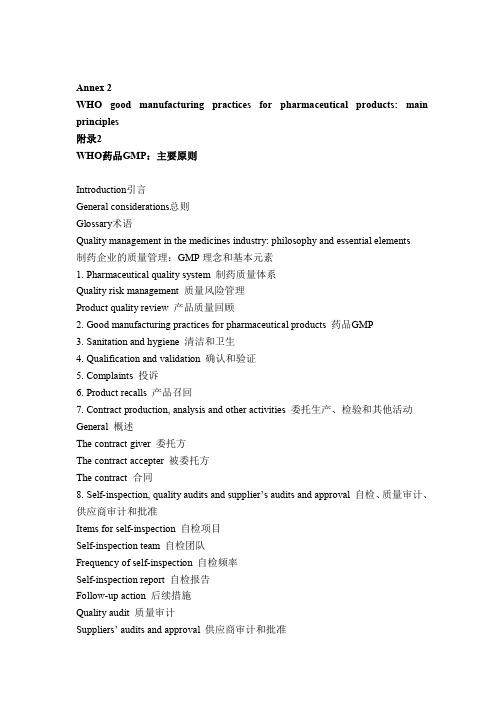
9. Personnel 人员 General 概述 Key personnel 关键人员 10. Training 培训 11. Personal hygiene 人员卫生 12. Premises 厂房 General 概述 Ancillary areas 辅助区域 Storage areas 仓储区域 Weighing areas 称量区域 Production areas 生产区域 Quality control areas QC区域 13. Equipment 设备 14. Materials 物料 General 概述 Starting materials 起始物料 Packaging materials 包装材料 Intermediate and bulk products 中间体和成品 Finished products 制剂 Rejected, recovered, reprocessed and reworked materials 不合格、回收、返工和重 加工物料 Recalled products 召回产品 Returned goods 退货 Reagents and culture media 试剂和培养基 Reference standards 标准品 Waste materials 废弃物料 Miscellaneous 其他 15. Documentation 文件 General 概述 Documents required 需要的文件 16. Good practices in production 生产良好规范 General 概述 Prevention of cross-contamination and bacterial contamination during production生产 过程中交叉污染和额细菌污染的预防
WHO_TRS_996_annex09翻译
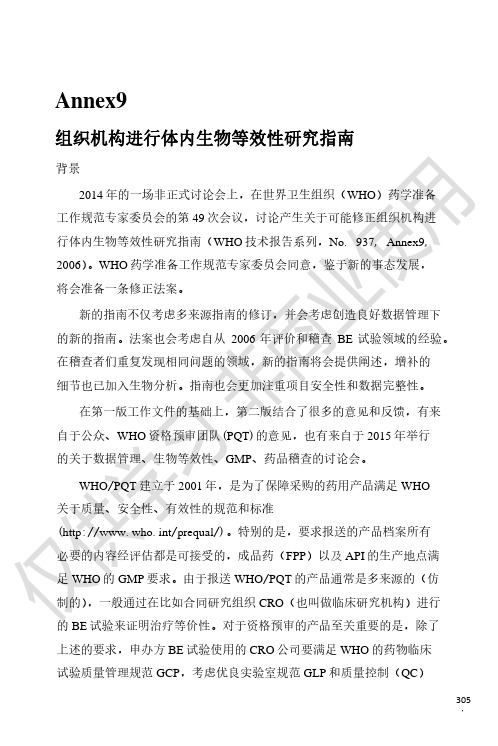
Annex9组织机构进行体内生物等效性研究指南背景2014年的一场非正式讨论会上,在世界卫生组织(WHO)药学准备工作规范专家委员会的第49次会议,讨论产生关于可能修正组织机构进行体内生物等效性研究指南(WHO技术报告系列,No. 937, Annex9, 2006)。
WHO药学准备工作规范专家委员会同意,鉴于新的事态发展,将会准备一条修正法案。
新的指南不仅考虑多来源指南的修订,并会考虑创造良好数据管理下的新的指南。
法案也会考虑自从2006年评价和稽查BE试验领域的经验。
在稽查者们重复发现相同问题的领域,新的指南将会提供阐述,增补的细节也已加入生物分析。
指南也会更加注重项目安全性和数据完整性。
在第一版工作文件的基础上,第二版结合了很多的意见和反馈,有来自于公众、WHO资格预审团队(PQT)的意见,也有来自于2015年举行的关于数据管理、生物等效性、GMP、药品稽查的讨论会。
WHO/PQT建立于2001年,是为了保障采购的药用产品满足WHO关于质量、安全性、有效性的规范和标准(http://www.who.int/prequal/)。
特别的是,要求报送的产品档案所有必要的内容经评估都是可接受的,成品药(FPP)以及API的生产地点满足WHO的GMP要求。
由于报送WHO/PQT的产品通常是多来源的(仿制的),一般通过在比如合同研究组织CRO(也叫做临床研究机构)进行的BE试验来证明治疗等价性。
对于资格预审的产品至关重要的是,除了上述的要求,申办方BE试验使用的CRO公司要满足WHO的药物临床试验质量管理规范GCP,考虑优良实验室规范GLP和质量控制(QC)305实验室管理规范来保证数据的完整性和可追溯性。
除此之外,如果存在当地的法律法规,CRO应该得到各自国家药品局的认可。
如果国家规定需要,BE试验应该获得国家监督管理局的授权。
因此报送资格预审的产品涉及到BE试验中执行和分析的,需要保证满足WHO相关的规范和标准,以便为WHO的稽查做准备。
WHO第技术报告药物生产技术转移指南中英文精编版

W H O第技术报告药物生产技术转移指南中英文公司标准化编码 [QQX96QT-XQQB89Q8-NQQJ6Q8-MQM9N]WHO第961号技术报告附件7 药物生产技术转移指南World Health OrganizationWHO Technical Report Series, No. 961, 2011WHO第961号技术报告附件7 药物生产技术转移指南?Annex 7?附件7WHO guidelines on transfer of technology in pharmaceutical manufacturingWHO药物生产技术转移指南1. Introduction?介绍2. Scope?范围3. Glossary?术语4. Organization and management?组织和管理5. Production: transfer (processing, packaging and cleaning)生产:转移(工艺、包装和清洁)6. Quality control: analytical method transfer质量控制:分析方法转移7. Premises and equipment?厂房设施和设备8. Documentation?文件9. Qualification and validation?确认和验证References?参考文献?1.Introduction?介绍These guiding principles on transfer of technology are intended to serve as a framework which can be applied in a flexible manner rather than as strict rigid guidance. Focus has been placed on the quality aspects, in line with WHO’s mandate.本指南中关于技术转移的原则意在作为一个框架,以不同方式应用,而不是一个需要严格遵守的指南。
ICH中英文对照版本

人用药物注册技术要求国际协调会议( I C H :International Conference on Harmonization of Technical Requirements for Registration of Pharmaceuticals forHuman Use)ICH三方协调指南原料药的优良制造规范(GMP)指南ICH指导委员会2000年11月10日按ICH规程第4步建议采用本指南根据ICH规程由合适的ICH专家工作组起草并经向法规部门咨询。
在规程的第4步,建议欧洲共同体、日本和美国的药政部门采用其最终的草案。
原料药的优良制造规范(GMP)指南ICH三方协调指南ICH指导委员会2000年11月10日的会议按ICH规程第4步建议ICH的三个药政部门采用本指南目录1 引言INTRODUCTION (6)1.1 目的Objective (6)1.2 法规的适用性Regulatory Applicability (7)1.3 范围Range (7)2 质量管理QUALITY MANAGEMENT (8)2.1 原则Principles (8)2.2 质量部门的职责Responsibilities of the Quality Unit(s) (9)2.3 生产作业的职责Responsibility for Production Activities (11)2.4 内部审计(自检)Internal Audits (Self Inspection) (12)2.5 产品质量审核Product Quality Review (12)3 人员PERSONNEL (13)3.1 员工的资质Personnel qualifications (13)3.2 员工的卫生Personnel Hygiene (13)3.3 顾问Consultants (14)4 建筑和设施BUILDINGS AND FACILITIES (14)4.1 设计和结构Design and Construction (14)4.2 公用设施Utilities (15)4.3 水Water (16)4.4 限制Containment (16)4.5 照明Lighting (17)4.6 排污和垃圾Sewage and Refuse (17)4.7 清洁和保养Sanitation and Maintenance (17)5 工艺设备PROCESS EQUIPMENT (17)5.1 设计和结构Design and Construction (18)5.2 设备保养和清洁Equipment Maintenance and Cleaning (18)5.3 校验Calibration (19)5.4 计算机控制系统Computerized Systems (20)6 文件和记录DOCUMENTA TION AND RECORDS (21)6.1 文件系统和规格Documentation System and Specifications (21)6.2 设备的清洁和使用记录Equipment Cleaning and Use Record (22)6.3 原料、中间体、原料药的标签和包装材料的记录Records of Materials , Intermediates, API Labeling andPackaging Materials (22)6.4 生产工艺规程Master Production Instructions (23)6.5 批生产记录Batch Production Records (24)6.6 实验室控制记录Laboratory Control Records (25)6.7 批生产记录审核Batch Production Record Review (26)7 物料管理MA TERIALS MANAGEMENT (26)7.1 控制通则General Controls (26)7.2 接收和待验Receipt and Quarantine (27)7.3 进厂物料的取样和测试Sampling and Testing of Incoming Production Materials (27)7.4 储存Storage (28)7.5 重新评估Re-evaluation (29)8 生产和中间控制PRODUCTION AND IN-PROCESS CONTROLS (29)8.1 生产操作Production Operations (29)8.2 时间限制Time Limits (30)8.3 工序间的取样和控制In-process Sampling and Controls (30)8.4 中间体或原料药的混合Blending Batches of Intermediates or APIs (31)8.5 污染的控制Contamination Control (32)9 原料药和中间体的包装和贴签PACKAGING AND IDENTIFICATION LABELING OF APIs AND INTERMEDIATES (32)9.1 总则General (32)9.2 包装材料Packaging Materials (33)9.3 标签的发放和控制Labeling Issuance and Control (33)9.4 包装和贴签操作Packaging and Labeling Operations (34)10 储存和分发STORAGE AND DISTRIBUTION (35)10.1 入库程序Warehousing Procedures (35)10.2 分发程序Distribution Procedures (35)11 实验室控制LABORATORY CONTROLS (35)11.1 控制通则General Controls (35)11.2 中间体和原料药的测试Testing of Intermediates and APIs (37)11.3 分析程序的验证-参见12章V alidation of Analytical Procedures - See Section 12. (11.3) (38)11.4 分析报告单Certificates of Analysis (38)11.5 原料药的稳定性监测Stability Monitorint of APIs (38)11.6 有效期和复验日期Expiry and Retest Dating (39)11.7 留样Reserve/Retention Samples (40)12 验证V ALIDATION (40)12.1 验证方针Validation Policy (40)12.2 验证文件Validation Documentation (41)12.3 确认Qualification (41)12.4 工艺验证的方法Approaches to Process Validation (42)12.5 工艺验证的程序Process Validation Program (43)12.7 清洗验证Cleaning V alidation (44)12.8 分析方法的验证Validation of Analytical Methods (45)13 变更的控制CHANGE CONTROL (45)14 物料的拒收和再用REJECTION AND RE-USE OF MATERIALS (46)14.1 拒收Rejection (47)14.2 返工Reprocessing (47)14.3 重新加工Reworking (47)14.4 物料和溶剂的回收Recovery of Materials and Solvents (48)14.5 退货Returns (48)15 投诉和召回COMPLAINTS AND RECALLS (49)16 协议制造商(包括实验室) CONTRACT MANUFACTURES (INCLUDING LABORATORIES) (49)17 代理商、经纪人、贸易商、经销商、重新包装者和重新贴签者 (50)AGENTS,BROKERS, TRADERS,DISTRIBUTORS,REPACKERS ,AND RELABELLERS (50)17.1 适用性Applicability (50)17.2 已分发原料药的可追溯性Traceability of Distributed APIs and Intermediates (50)17.3 质量管理Quality Management (51)17.4 原料药和中间体的重新包装、重新贴签和待检Repackaging,Relabeling,and Holding of APIs and Intermediates. (51)17.5 稳定性Stability (51)17.6 信息的传达Transfer of Information (51)17.7 投诉和召回的处理Handing of Complaints and Recalls (52)17.8 退货的处理Handing of Returns (52)18 用细胞繁殖/发酵生产的原料药的特殊指南 (53)SPECIFIC GUIDANCE FOR APIs MANUFACTURED BY CELL CULTURE/FERMENTATION (53)18.1 总则General (53)18.2 细胞库的维护和记录的保存Cell Bank Maintenance and Record Keeping (55)18.3 细胞繁殖/发酵Cell Culture/Fermentation (55)18.4 收取、分离和精制Harvesting, Isolation and Purifation (56)18.5 病毒的去除/灭活步骤Viral Removal/Inactivation Steps (57)19 用于临床研究的原料药(APIS FOR USE IN CLINICAL TRIALS) (57)19.1 总则General (57)19.2 质量quality (58)19.3 设备和设施Equipment and Facilities (58)19.4 原料的控制Control of Raw Materials (58)19.5 生产Production (59)19.6 验证Validation (59)19.7 变更Changes (59)19.8 实验室控制Laboratory Controls (59)19.9 文件Documentation (60)20. 术语表(GLOOSSARY) (60)原料药的优良制造规范(GMP) 指南Guidance for IndustryQ7A Good Manufacturing Practice Guidancefor Active Pharmaceutical IngredientsThis guidance represents the Food and Drug Administration's (FDA's) current thinking on this topic. It does not create or confer any rights for or on any person and does not operate to bind FDA or the public. An alternative approach may be used if such approach satisfies the requirements of the applicable statutes and regulations.1 引言INTRODUCTION1.1 目的Objective本文件(指南)旨在为在合适的质量管理体系下制造活性药用成分(原料药以下称原料药)提供有关优良药品生产管理规范(GMP)提供指南。
WHO 制药生产技术转移指南(2020草案)中英文对照版
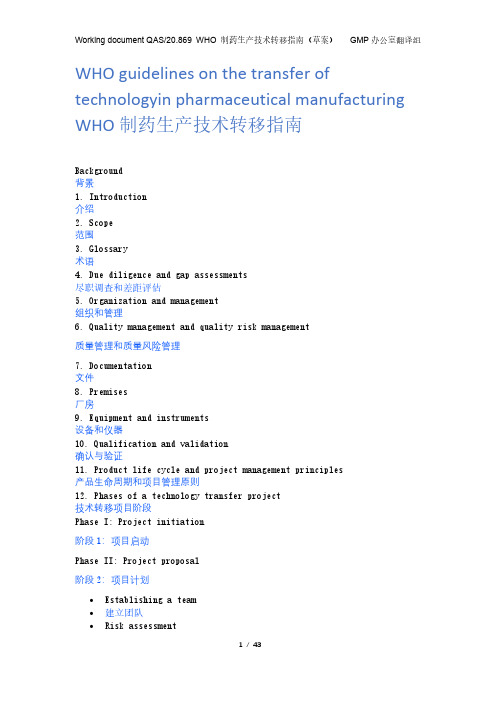
WHO guidelines on the transfer of technologyin pharmaceutical manufacturing WHO制药生产技术转移指南Background背景1. Introduction介绍2. Scope范围3. Glossary术语4. Due diligence and gap assessments尽职调查和差距评估5. Organization and management组织和管理6. Quality management and quality risk management质量管理和质量风险管理7. Documentation文件8. Premises厂房9. Equipment and instruments设备和仪器10. Qualification and validation确认与验证11. Product life cycle and project management principles产品生命周期和项目管理原则12. Phases of a technology transfer project技术转移项目阶段Phase I: Project initiation阶段1:项目启动Phase II: Project proposal阶段2:项目计划•Establishing a team•建立团队•Risk assessment•风险评估•Project plan•项目计划•Control strategy•控制策略Phase III: Project transfer阶段3项目转移•Production: transfer (processing, packaging)•生产:转移(工艺、包装)•Starting materials•起始物料•Active pharmaceutical ingredients•活性药物成分•Excipients•辅料•Information on process and finished pharmaceutical products information•关于工艺和药物成品的信息•Packaging•包装•Quality control: analytical method transfer•质量控制:分析方法转移•Cleaning•清洁Phase IV: Project review阶段4:项目回顾References参考文献Further reading拓展阅读Abbreviations缩略语Appendix 1. Example of documentation commonly required for the transferof technology附录1. 技术转移通常需要的文件示例Appendix 2. Example of possible experimental designs and acceptancecriteria for analytical testing附录2. 分析测试可能的实验设计和接受标准示例1. Introduction介绍1.1. Production and control procedures, validation and otherrelated activities may be transferred from one site to another site prior toobtaining a marketing authorization. In some cases, this transfer takes placeafter the approval of, for example, a product, by a regulatory authority. Thistransfer can be, for example, from drug discovery to product development; toclinical trials; or to full-scale commercialization and commercial batchmanufacturing; cleaning and validation.在获得上市许可之前,生产和控制程序、验证和其他相关活动可能从一个场所转移到另一个查场所。
导读大纲-WHO技术转移指南

导读大纲资料名称:WHO药品生产技术转移指南(WHO guidelines on transfer of technology in pharmaceutical manufacturing)资料来源:WHO官方网站I.内容简介:本指南从技术转移过程中所应遵循的原则、要求,技术转移的组织管理方法,技术转移所应涵盖的主要部分(包括生产工艺、质控分析方法、场地设备和文件、确认和验证)提供了指导。
它所提供的是一个技术转移的框架,目的是按照框架灵活的应用,而不是要严格地按照指南进行操作。
II.指南目录:1. 介绍2. 范围3. 词汇4. 机构和管理5. 生产:转移(工艺、包装和清洁)6. 质控:分析方法转移7. 厂房和设备8. 文件9. 确认和验证III.指南内容:1. 简介什么时候会进行技术转移;技术转移的定义;其他技术转移方面的指南信息;技术转移涉及到的主要的工作;成功地进行技术转移所要遵循的原则和要求;技术转移的成功标准;转移过程中发现问题双方要及时沟通;公司之间的技术转移进行前要考虑的问题;转移过程要透明等。
◆技术转移的定义:技术转移是指控制所有研发和生产单位或生产和生产单位之间进行的所有过程、相关文件以及经验转移的有逻辑性的过程。
◆成功进行技术转移所要遵循的原则和要求:✓项目计划应该涵盖项目的所有质量方面并且给予质量风险管理进行。
✓SU和RU的能力应该接近,没有必要完全相同,厂房设施所依据的操作原则应该相似。
✓应该进行全面的SU和RU之间的差异分析,包括技术风险评估和法规符合性差异。
✓RU应该有充足的人力资源,并且经过充分的培训。
培训时应该考虑到SU和RU苏在国家的法规要求、产品投放国的法规要求和有效的产品工艺和产品知识的转移。
2. 范围本指南适用于公司内部的转移,公司和公司之间的转移;产品适用于API,精细原料的生产和包装,所有剂型的制剂的生产和包装,以及分析方法的转移;指南不提供法律,财务和商业方面的指导。
ICH中英文对照版本

人用药物注册技术要求国际协调会议( I C H :International Conference on Harmonization of Technical Requirements for Registration of Pharmaceuticals forHuman Use)ICH三方协调指南原料药的优良制造规范(GMP)指南ICH指导委员会2000年11月10日按ICH规程第4步建议采用本指南根据ICH规程由合适的ICH专家工作组起草并经向法规部门咨询。
在规程的第4步,建议欧洲共同体、日本和美国的药政部门采用其最终的草案。
原料药的优良制造规范(GMP)指南ICH三方协调指南ICH指导委员会2000年11月10日的会议按ICH规程第4步建议ICH的三个药政部门采用本指南目录1 引言INTRODUCTION (6)1.1 目的Objective (6)1.2 法规的适用性Regulatory Applicability (7)1.3 范围Range (7)2 质量管理QUALITY MANAGEMENT (8)2.1 原则Principles (8)2.2 质量部门的职责Responsibilities of the Quality Unit(s) (9)2.3 生产作业的职责Responsibility for Production Activities (11)2.4 内部审计(自检)Internal Audits (Self Inspection) (12)2.5 产品质量审核Product Quality Review (12)3 人员PERSONNEL (13)3.1 员工的资质Personnel qualifications (13)3.2 员工的卫生Personnel Hygiene (13)3.3 顾问Consultants (14)4 建筑和设施BUILDINGS AND FACILITIES (14)4.1 设计和结构Design and Construction (14)4.2 公用设施Utilities (15)4.3 水Water (16)4.4 限制Containment (16)4.5 照明Lighting (17)4.6 排污和垃圾Sewage and Refuse (17)4.7 清洁和保养Sanitation and Maintenance (17)5 工艺设备PROCESS EQUIPMENT (17)5.1 设计和结构Design and Construction (18)5.2 设备保养和清洁Equipment Maintenance and Cleaning (18)5.3 校验Calibration (19)5.4 计算机控制系统Computerized Systems (20)6 文件和记录DOCUMENTA TION AND RECORDS (21)6.1 文件系统和规格Documentation System and Specifications (21)6.2 设备的清洁和使用记录Equipment Cleaning and Use Record (22)6.3 原料、中间体、原料药的标签和包装材料的记录Records of Materials , Intermediates, API Labeling andPackaging Materials (22)6.4 生产工艺规程Master Production Instructions (23)6.5 批生产记录Batch Production Records (24)6.6 实验室控制记录Laboratory Control Records (25)6.7 批生产记录审核Batch Production Record Review (26)7 物料管理MA TERIALS MANAGEMENT (26)7.1 控制通则General Controls (26)7.2 接收和待验Receipt and Quarantine (27)7.3 进厂物料的取样和测试Sampling and Testing of Incoming Production Materials (27)7.4 储存Storage (28)7.5 重新评估Re-evaluation (29)8 生产和中间控制PRODUCTION AND IN-PROCESS CONTROLS (29)8.1 生产操作Production Operations (29)8.2 时间限制Time Limits (30)8.3 工序间的取样和控制In-process Sampling and Controls (30)8.4 中间体或原料药的混合Blending Batches of Intermediates or APIs (31)8.5 污染的控制Contamination Control (32)9 原料药和中间体的包装和贴签PACKAGING AND IDENTIFICATION LABELING OF APIs AND INTERMEDIATES (32)9.1 总则General (32)9.2 包装材料Packaging Materials (33)9.3 标签的发放和控制Labeling Issuance and Control (33)9.4 包装和贴签操作Packaging and Labeling Operations (34)10 储存和分发STORAGE AND DISTRIBUTION (35)10.1 入库程序Warehousing Procedures (35)10.2 分发程序Distribution Procedures (35)11 实验室控制LABORATORY CONTROLS (35)11.1 控制通则General Controls (35)11.2 中间体和原料药的测试Testing of Intermediates and APIs (37)11.3 分析程序的验证-参见12章V alidation of Analytical Procedures - See Section 12. (11.3) (38)11.4 分析报告单Certificates of Analysis (38)11.5 原料药的稳定性监测Stability Monitorint of APIs (38)11.6 有效期和复验日期Expiry and Retest Dating (39)11.7 留样Reserve/Retention Samples (40)12 验证V ALIDATION (40)12.1 验证方针Validation Policy (40)12.2 验证文件Validation Documentation (41)12.3 确认Qualification (41)12.4 工艺验证的方法Approaches to Process Validation (42)12.5 工艺验证的程序Process Validation Program (43)12.7 清洗验证Cleaning V alidation (44)12.8 分析方法的验证Validation of Analytical Methods (45)13 变更的控制CHANGE CONTROL (45)14 物料的拒收和再用REJECTION AND RE-USE OF MATERIALS (46)14.1 拒收Rejection (47)14.2 返工Reprocessing (47)14.3 重新加工Reworking (47)14.4 物料和溶剂的回收Recovery of Materials and Solvents (48)14.5 退货Returns (48)15 投诉和召回COMPLAINTS AND RECALLS (49)16 协议制造商(包括实验室) CONTRACT MANUFACTURES (INCLUDING LABORATORIES) (49)17 代理商、经纪人、贸易商、经销商、重新包装者和重新贴签者 (50)AGENTS,BROKERS, TRADERS,DISTRIBUTORS,REPACKERS ,AND RELABELLERS (50)17.1 适用性Applicability (50)17.2 已分发原料药的可追溯性Traceability of Distributed APIs and Intermediates (50)17.3 质量管理Quality Management (51)17.4 原料药和中间体的重新包装、重新贴签和待检Repackaging,Relabeling,and Holding of APIs and Intermediates. (51)17.5 稳定性Stability (51)17.6 信息的传达Transfer of Information (51)17.7 投诉和召回的处理Handing of Complaints and Recalls (52)17.8 退货的处理Handing of Returns (52)18 用细胞繁殖/发酵生产的原料药的特殊指南 (53)SPECIFIC GUIDANCE FOR APIs MANUFACTURED BY CELL CULTURE/FERMENTATION (53)18.1 总则General (53)18.2 细胞库的维护和记录的保存Cell Bank Maintenance and Record Keeping (55)18.3 细胞繁殖/发酵Cell Culture/Fermentation (55)18.4 收取、分离和精制Harvesting, Isolation and Purifation (56)18.5 病毒的去除/灭活步骤Viral Removal/Inactivation Steps (57)19 用于临床研究的原料药(APIS FOR USE IN CLINICAL TRIALS) (57)19.1 总则General (57)19.2 质量quality (58)19.3 设备和设施Equipment and Facilities (58)19.4 原料的控制Control of Raw Materials (58)19.5 生产Production (59)19.6 验证Validation (59)19.7 变更Changes (59)19.8 实验室控制Laboratory Controls (59)19.9 文件Documentation (60)20. 术语表(GLOOSSARY) (60)原料药的优良制造规范(GMP) 指南Guidance for IndustryQ7A Good Manufacturing Practice Guidancefor Active Pharmaceutical IngredientsThis guidance represents the Food and Drug Administration's (FDA's) current thinking on this topic. It does not create or confer any rights for or on any person and does not operate to bind FDA or the public. An alternative approach may be used if such approach satisfies the requirements of the applicable statutes and regulations.1 引言INTRODUCTION1.1 目的Objective本文件(指南)旨在为在合适的质量管理体系下制造活性药用成分(原料药以下称原料药)提供有关优良药品生产管理规范(GMP)提供指南。
最新WHO986号技术报告GMP准则,第一章:质量体系(之一),

最新WHO986号技术报告GMP准则,第一章:质量体系(之一),2014-10-18目录1. Pharmaceutical quality system 852. Good manufacturing practices for pharmaceutical products 903. Sanitation and hygiene 914. Qualification and validation 915. Complaints 926. Product recalls 937. Contract production, analysis and other activities 948. Self-inspection, quality audits and suppliers’ audits and approval 979. Personnel 9910. Training 10311. Personal hygiene 10312. Premises 10413. Equipment 10814. Materials 10915. Documentation 11516. Good practices in production 12517. Good practices in quality control 1291. Pharmaceutical quality system 制药质量体系1.1. Principle. The manufacturer must assume responsibility for the quality of the pharmaceutical products to ensure that they are fit for their intended use, comply with the requirements of the marketing authorization and do not place patients at risk due to inadequate safety, quality or efficacy.原则:生产者必须承担制药产品的质量职责确保产品符合预期使用目的,符合上市许可的要求,不会因为安全性、质量或疗效的不足给患者造成风险。
ISPE(国际制药工程协会)新药转移技术指南(中文版)
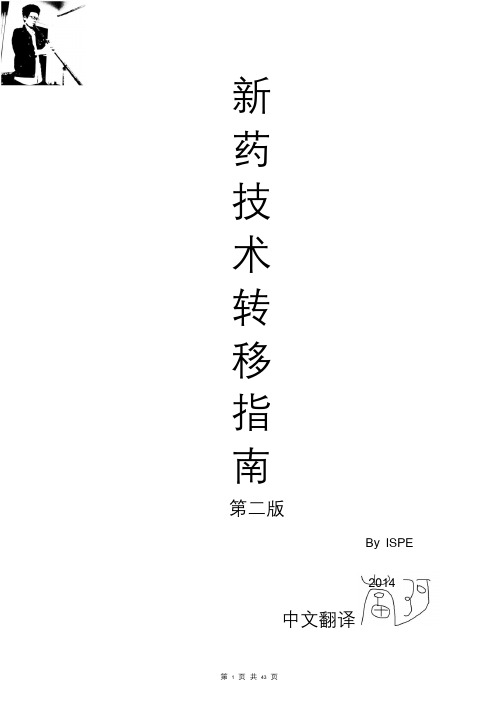
新药技术转移指南第二版By ISPE2014中文翻译第1页共43页引言 (5)1.1背景和目的 (5)1.2第二版的理论依据 (5)1.2.1产品生命周期 (6)1.2.2产品质量目标 (6)1.2.3控制策略 (6)1.2.4质量风险管理 (7)1.2.5沟通渠道 (7)1.3范围 (7)1.4关键术语 (8)1.5短缺药物的技术转移 (8)2技术转移计划以及成功标准 (9)2.1简介 (9)2.2技术转移计划 (9)2.3技术转移成功标准 (12)3技术转移时期 (14)3.1建立转移团队和制定章程 (14)3.1.1建立团队 (14)3.1.2建立章程 (16)3.2强化技术转移知识&建立技术转移方案 (17)3.2.1技术转移方案 (17)3.2.2技术转移包 (18)第2页共43页3.3风险识别,组织风险评估,建立技术转移计划 (19)3.3.1风险识别 (20)3.3.2风险分析和评价 (21)3.3.3技术转移计划 (23)3.4技术转移的执行 (24)3.5工艺(方法)验证 (26)3.6转移终结和回顾 (27)3.6.1技术转移过度计划&发出部门的脱离 (27)3.6.2监管活动的应对 (28)3.6.3学到的知识 (28)4分析方法的知识转移 (29)4.1简介 (29)4.2转移过程概述 (29)4.2.1建立技术转移团队和制定章程 (29)4.2.2强化转移知识并同意高水平的技术转移方案 (30)4.2.3风险识别,风险评估与技术转移计划 (30)4.2.4技术转移执行期 (32)4.2.5方法验证 (32)4.2.6转移结束与总结 (33)5原料药技术转移 (33)5.1简介 (33)5.2技术转移过程 (33)第3页共43页5.2.1强化转移知识并同意高水平的技术转移方案 (33)5.2.2工艺验证 (35)5.2.3转移终结与回顾 (36)6制剂转移技术 (37)6.1简介 (37)6.2技术转移过程 (37)6.2.1风险识别、风险评估、技术转移计划 (37)6.2.2工艺验证 (37)7附录一薄膜包衣片产品质量目标实例 (39)8附录二无菌制剂产品质量目标实例 (40)9附录三技术转移报告中可能包含的信息 (41)第4页共43页引言1.1背景和目的是药物研发和商业化生产的必要部分。
ISPE(国际制药工程协会)新药转移技术指南(中文版)

新药技术转移指南第二版By ISPE2014中文翻译第1页共43页引言 (5)1.1背景和目的 (5)1.2第二版的理论依据 (5)1.2.1产品生命周期 (6)1.2.2产品质量目标 (6)1.2.3控制策略 (6)1.2.4质量风险管理 (7)1.2.5沟通渠道 (7)1.3范围 (7)1.4关键术语 (8)1.5短缺药物的技术转移 (8)2技术转移计划以及成功标准 (9)2.1简介 (9)2.2技术转移计划 (9)2.3技术转移成功标准 (12)3技术转移时期 (14)3.1建立转移团队和制定章程 (14)3.1.1建立团队 (14)3.1.2建立章程 (16)3.2强化技术转移知识&建立技术转移方案 (17)3.2.1技术转移方案 (17)3.2.2技术转移包 (18)第2页共43页3.3风险识别,组织风险评估,建立技术转移计划 (19)3.3.1风险识别 (20)3.3.2风险分析和评价 (21)3.3.3技术转移计划 (23)3.4技术转移的执行 (24)3.5工艺(方法)验证 (26)3.6转移终结和回顾 (27)3.6.1技术转移过度计划&发出部门的脱离 (27)3.6.2监管活动的应对 (28)3.6.3学到的知识 (28)4分析方法的知识转移 (29)4.1简介 (29)4.2转移过程概述 (29)4.2.1建立技术转移团队和制定章程 (29)4.2.2强化转移知识并同意高水平的技术转移方案 (30)4.2.3风险识别,风险评估与技术转移计划 (30)4.2.4技术转移执行期 (32)4.2.5方法验证 (32)4.2.6转移结束与总结 (33)5原料药技术转移 (33)5.1简介 (33)5.2技术转移过程 (33)第3页共43页5.2.1强化转移知识并同意高水平的技术转移方案 (33)5.2.2工艺验证 (35)5.2.3转移终结与回顾 (36)6制剂转移技术 (37)6.1简介 (37)6.2技术转移过程 (37)6.2.1风险识别、风险评估、技术转移计划 (37)6.2.2工艺验证 (37)7附录一薄膜包衣片产品质量目标实例 (39)8附录二无菌制剂产品质量目标实例 (40)9附录三技术转移报告中可能包含的信息 (41)第4页共43页引言1.1背景和目的是药物研发和商业化生产的必要部分。
WHO技术转移指南
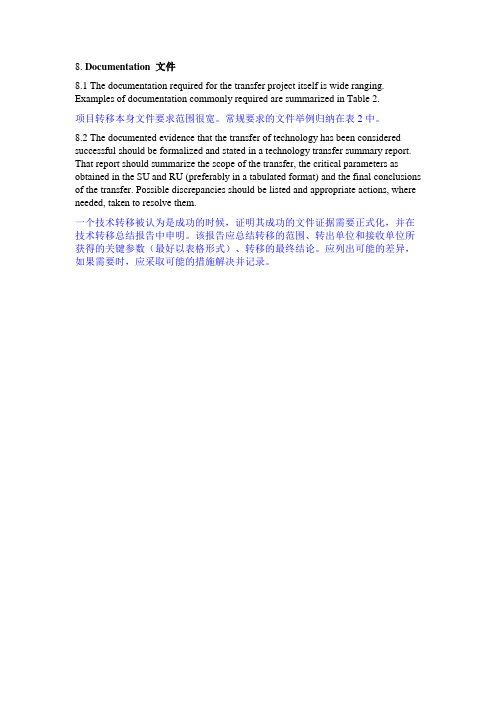
8. Documentation 文件8.1 The documentation required for the transfer project itself is wide ranging. Examples of documentation commonly required are summarized in Table 2.项目转移本身文件要求范围很宽。
常规要求的文件举例归纳在表2中。
8.2 The documented evidence that the transfer of technology has been considered successful should be formalized and stated in a technology transfer summary report. That report should summarize the scope of the transfer, the critical parameters as obtained in the SU and RU (preferably in a tabulated format) and the final conclusions of the transfer. Possible discrepancies should be listed and appropriate actions, where needed, taken to resolve them.一个技术转移被认为是成功的时候,证明其成功的文件证据需要正式化,并在技术转移总结报告中申明。
该报告应总结转移的范围、转出单位和接收单位所获得的关键参数(最好以表格形式)、转移的最终结论。
应列出可能的差异,如果需要时,应采取可能的措施解决并记录。
Table 2 表2Examples of documentation for transfer of technology (TOT)DQ, design qualification; IQ, installation qualification; OQ, operational qualification; API, active pharmaceutical ingredient; SOPs, standard operating procedures; RU, receiving unit.DQ 设计确认IQ 安装确认OQ 运行确认API 活性药物成分SOPs标准操作规程RU 接收单位9. Qualification and validation 确认和验证General 一般说明9.1 The extent of qualification and or validation (18) to be performed should be determined on the basis of risk management principles.需要进行的确认和/或验证(18)的深度应在风险管理原则的基础上决定。
WHO报告对技术转移的详细指南(5篇)
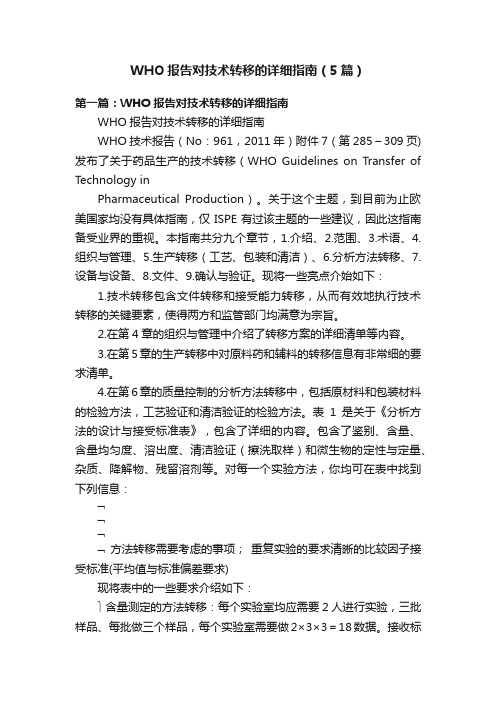
WHO报告对技术转移的详细指南(5篇)第一篇:WHO报告对技术转移的详细指南WHO报告对技术转移的详细指南WHO技术报告(No:961,2011年)附件7(第285 – 309页)发布了关于药品生产的技术转移(WHO Guidelines on Transfer of Technology inPharmaceutical Production)。
关于这个主题,到目前为止欧美国家均没有具体指南,仅ISPE有过该主题的一些建议,因此这指南备受业界的重视。
本指南共分九个章节,1.介绍、2.范围、3.术语、4.组织与管理、5.生产转移(工艺、包装和清洁)、6.分析方法转移、7.设备与设备、8.文件、9.确认与验证。
现将一些亮点介始如下:1.技术转移包含文件转移和接受能力转移,从而有效地执行技术转移的关键要素,使得两方和监管部门均满意为宗旨。
2.在第4章的组织与管理中介绍了转移方案的详细清单等内容。
3.在第5章的生产转移中对原料药和辅料的转移信息有非常细的要求清单。
4.在第6章的质量控制的分析方法转移中,包括原材料和包装材料的检验方法,工艺验证和清洁验证的检验方法。
表1是关于《分析方法的设计与接受标准表》,包含了详细的内容。
包含了鉴别、含量、含量均匀度、溶出度、清洁验证(擦洗取样)和微生物的定性与定量、杂质、降解物、残留溶剂等。
对每一个实验方法,你均可在表中找到下列信息:⌝⌝⌝⌝方法转移需要考虑的事项;重复实验的要求清晰的比较因子接受标准(平均值与标准偏差要求)现将表中的一些要求介绍如下:⎫含量测定的方法转移:每个实验室均应需要2人进行实验,三批样品、每批做三个样品,每个实验室需要做2×3×3=18数据。
接收标准是两个实验室的平均值应≤2%;⎫溶出度的方法转移:每个实验室均应需要2人进行实验,一批样品,接收标准是两个实验室的平均值应≤±3%;⎫含量均匀度的方法转移:每个实验室均应6片,一批样品,接收标准是两个实验室的平均值应≤±5%;⎫杂质、降解物、残留溶剂的方法转移:考虑的因子有RRT、定量限、图谱比较、准确度和中间精密度。
药品生产常用词汇中英文对照表

药品生产常用词汇中英文对照表环境,健康,安全environment,health, safety,E H S质量风险管理quality risk management, Q R M风险评估risk assessment风险控制risk control事先危害分析preliminary hazard analysis, P H A失败模式效果分析failure mode effects analysis,F M E A危害分析及主要控制点hazard analysis and critical control points, H A C C P 过失树分析fault tree analysis, FTA两次失败之间的平均时间mean time between failure, M T B F主题事务专家subject matter expert, S M E缎带式混合机ribbon blender在线清洗clean in place,CIP锥型混合机conical screw blender辊压制粒roller compaction压片能力compressibility导流管wurster column中间过程控制in process control, IPC物料桶intermediary bulk containers, IBCs关键工艺参数critical process parameters, CPP工艺验证process validation前验证/前瞻性验证prospective validation同步验证concurrent validation回顾性验证retrospective validation个人防护设备personal protective equipment, PPE职业暴露限值occupational exposure limit, O E L职业暴露等级occupational exposure bands, O E B口服固体制剂oral solid dosage, OSD人流/物流person flow / material flow药物活性成分active pharmaceutical ingredients,API中间体intermediate products需氧细菌aerobic bacteria安瓿瓶ampoule厌氧细菌anaerobic bacteria空态洁净区as - bulit clean room无菌生产aseptic processing静态at - rest灭菌釜‘ autoclave微生物污染水平bioburden生物指示剂biological indicators吹灌封blow/fill/seal玻璃瓶bottle轧盖capping洁净区clean area洁净级别cleanliness level在线清洗clean in place, CIP洁净室clean room菌落数colony forming unit, C F U组分component压缩气体compressed gas污染contaminant关键区域critical areas关键表面critical surfaces菌种保藏culture preservation脱水培养基dehydrated media隧道烘箱depyrogenating tunnel消毒disinfection直接接种法direct inoculation method干热灭菌法dry heat sterilization染色浴dye bath混悬剂emulsion内毒素endotoxin环氧乙烷ethylene oxide面罩face mask灌装filling硫乙醇酸盐流体培养基fluid thioglycollate medium词汇表脆碎性friability真菌fungi着装gowning热分布heat distribution热穿透heat penetration供热通风与空气调节heating, ventilation and air conditioning, H V A C 高效空气过滤器high efficiency particulate air filter, H E P A高压电检漏high frequency crack test高风险操作high risk operations疏水性hydrophobic behaviour卫生hygiene完整性integrity干预intervention辐射irradiation隔离器isolator层流laminar flow缓冲容器level vessel培养基灌装media filling微生物学microbiology微生物microorganism含多种溶剂的混合溶剂mixtures of various solvents改良马丁培养基modified Martin medium监测计划monitoring program阴性对照negative control软膏剂ointments眼用制剂ophthalmic preparation参数放行parametric release未完全密封状态partially closed state微粒particulate悬浮粒子particle增塑剂plasticizer日允许接触剂量permitted daily exposure, PDE极化过滤器polarisation filter阳性对照positive control内包装材料primary package materials非无菌单元的概率probability of non - sterile unit, PNSU 无菌工艺模拟试验process stimulation test保护性眼罩protective goggle热原pyrogen无菌药品Aseptic drug快速传递口rapid transfer ports, RTPs即灭菌胶塞ready for sterilization stoppers,RFS即用胶塞ready for use stoppers, R F U回收测试recovery test冗余过滤redundant filtration储料罐reservoir限制进出隔离系统restricted access barrier system, R A RS 清洁sanitization沉降碟法settle plates区域隔离sit - over大豆胰蛋白胨培养基soybean - casein digest medium质量标准specifications孢子spore杀孢子剂sporicidal标准操作规程standard operation procedure, SOP无菌保证水平sterility assurance level, SAL无菌检査sterility test无菌药品sterile pharmaceutical products灭菌sterilization在线灭菌sterilization in place, SIP储液罐storage vessel表面取样法surface sampling最终灭菌terminal sterilization总有机碳total organic carbon, T O C透明度transparency紊流turbulence单向流unidirectional airflow用户需求标准user requirement specifications,URS西林瓶vial目检visual inspection定量空气法volumetric air称量箱weighing boxes最差条件worst case基本设计basic design按批次生产batch - based production混合blending混批blending batches阶段性生产campaign - based production清场cleanance or site cleaning在线清洗clean in place, CIP概念设计concept design连续生产continuous production委托生产contract manufacture委托检验contract analysis关键偏差critical deviation关键工艺参数critical process parameter, CPP关键操作步骤critical processing step交叉污染cross contamination设计确认design qualification,DQ详细设计detailed design设备使用日志equipment logbook预期收率expected yield有效期expiry date良好工程实践good engineering practice, GEPC 存期holding time杂质档案impurity profile过程控制in _ process control过程取样in _ process sampling安装确认installation qualification, IQ中间体intermediate维护基本实践maintenance basic practice维护最佳实践maintenance best practice,维护良好实践maintenance good practice维护计划maintenance plan维护管理程序maintenance program主细胞库master cell b a n k ,MCB主生产和控制记录master production and control record, MP&CR 不合格non - conformance运行确认operation qualification, OQ原料药续表超标out of specification , OOS性能确认performance qualification, PQ原始细胞库preliminary cell b a n k ,PCB质量协.quality agreement质量审核quality review快速传递接口rapid transfer port,RTP物料平衡reconciliation拒收reject复验期retest date环境、健康及安全safety, environment, health, EHS 半连续生产semi - continuous production质量标准。
【行业资讯】ISPE发布第三版技术转移指南(中英对照版)
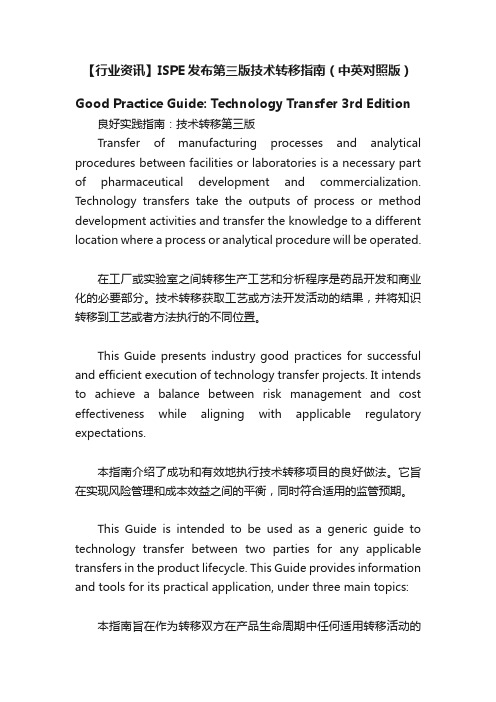
【行业资讯】ISPE发布第三版技术转移指南(中英对照版)Good Practice Guide: Technology Transfer 3rd Edition 良好实践指南:技术转移第三版Transfer of manufacturing processes and analytical procedures between facilities or laboratories is a necessary part of pharmaceutical development and commercialization. Technology transfers take the outputs of process or method development activities and transfer the knowledge to a different location where a process or analytical procedure will be operated.在工厂或实验室之间转移生产工艺和分析程序是药品开发和商业化的必要部分。
技术转移获取工艺或方法开发活动的结果,并将知识转移到工艺或者方法执行的不同位置。
This Guide presents industry good practices for successful and efficient execution of technology transfer projects. It intends to achieve a balance between risk management and cost effectiveness while aligning with applicable regulatory expectations.本指南介绍了成功和有效地执行技术转移项目的良好做法。
它旨在实现风险管理和成本效益之间的平衡,同时符合适用的监管预期。
WHO最新指南(对照阅读)

WHO最新指南(对照阅读)12月4日,世界卫生组织(W H O)于发布《药品生产技术转移指南》(W H O g ui d e l i n e s o n t h e t r a ns f e r of t e c h n o l o g y i np h a r m a c e ut i c a l m an u f ac t u r i n g),提供了药品技术转让期间应考虑的指导原则。
本指南主体部分分为12个章节,内容如下:背景1.简介2.范围3.术语4.尽职调查和差距评估5.组织与管理6.质量管理和质量风险管理7.文件8.设施9.设备和仪器10.确认和验证11.产品生命周期和项目管理原则12.技术转移项目阶段往期推荐(1)药品生产技术转移:概述(2)药品技术转移,40个术语(3)药品技术转移:如何评估组织?(4)药品技术转移:设施设备上有哪些考虑?(5)药品技术转移:确认和验证上有哪些考虑?(5)药品技术转移:项目阶段如何设计?以下是该指南的12章(下)内容:12. 技术转移项目阶段(下)Information on process and finished pharmaceutical product information工艺信息和成品信息Processing, packaging 工艺、包装12.15.Pr o d u c t,p r o c e s s a n d p r o c e d u r e k n o w l e d ge s h o u l d b e a ne s se n t i a l p a r t of t h e t r a n s f e r p r o c e s s f r o m S U t o R U.产品、工艺和程序知识应该是从S U到R U的转移的重要组成部分。
12.16.T h e q u a l i t y t a r g e t p r o d u c t p r o f i l e,c r i t i c a l q u a l i t y a t t r i b u t e s,c r i t i c a l p r o c e ss p a r a m e t e r s,m a t e r i a l a t t r i b u t e s,c o n t r o l s t r a t e g y a nd a n y o t he r i m p a c t i n g e l e m e n t s o n t h e q u a l i t y of t h e p r o d u c t s h o u l d b e a v a i l a b l e.(S e e a l so I C Hg u i d e l i n e s.)质量目标产品概况、关键质量属性、关键工艺参数、物料属性、控制策略、以及对产品质量有任何其它影响的要素,都应可以提供。
WHO技术转移指南

8. Documentation 文件8.1 The documentation required for the transfer project itself is wide ranging. Examples of documentation commonly required are summarized in Table 2.项目转移本身文件要求范围很宽。
常规要求的文件举例归纳在表2中。
8.2 The documented evidence that the transfer of technology has been considered successful should be formalized and stated in a technology transfer summary report. That report should summarize the scope of the transfer, the critical parameters as obtained in the SU and RU (preferably in a tabulated format) and the final conclusions of the transfer. Possible discrepancies should be listed and appropriate actions, where needed, taken to resolve them.一个技术转移被认为是成功的时候,证明其成功的文件证据需要正式化,并在技术转移总结报告中申明。
该报告应总结转移的范围、转出单位和接收单位所获得的关键参数(最好以表格形式)、转移的最终结论。
应列出可能的差异,如果需要时,应采取可能的措施解决并记录。
Table 2 表2Examples of documentation for transfer of technology (TOT)DQ, design qualification; IQ, installation qualification; OQ, operational qualification; API, active pharmaceutical ingredient; SOPs, standard operating procedures; RU, receiving unit.DQ 设计确认IQ 安装确认OQ 运行确认API 活性药物成分SOPs标准操作规程RU 接收单位9. Qualification and validation 确认和验证General 一般说明9.1 The extent of qualification and or validation (18) to be performed should be determined on the basis of risk management principles.需要进行的确认和/或验证(18)的深度应在风险管理原则的基础上决定。
Annex 14工厂主文件准备指南
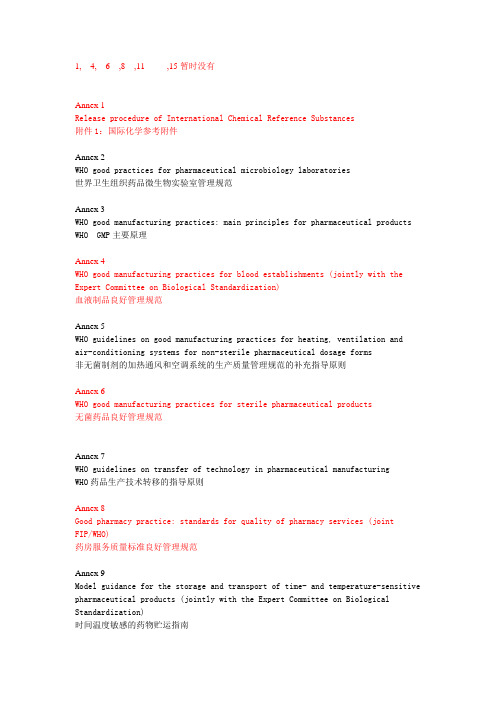
1, 4, 6 ,8 ,11 ,15暂时没有Annex 1Release procedure of International Chemical Reference Substances附件1:国际化学参考附件Annex 2WHO good practices for pharmaceutical microbiology laboratories世界卫生组织药品微生物实验室管理规范Annex 3WHO good manufacturing practices: main principles for pharmaceutical products WHO GMP主要原理Annex 4WHO good manufacturing practices for blood establishments (jointly with the Expert Committee on Biological Standardization)血液制品良好管理规范Annex 5WHO guidelines on good manufacturing practices for heating, ventilation andair-conditioning systems for non-sterile pharmaceutical dosage forms非无菌制剂的加热通风和空调系统的生产质量管理规范的补充指导原则Annex 6WHO good manufacturing practices for sterile pharmaceutical products无菌药品良好管理规范Annex 7WHO guidelines on transfer of technology in pharmaceutical manufacturingWHO药品生产技术转移的指导原则Annex 8Good pharmacy practice: standards for quality of pharmacy services (jointFIP/WHO)药房服务质量标准良好管理规范Annex 9Model guidance for the storage and transport of time- and temperature-sensitive pharmaceutical products (jointly with the Expert Committee on Biological Standardization)时间温度敏感的药物贮运指南Annex 10Procedure for prequalification of pharmaceutical products vi药品的预认证程序Annex 11Guidelines on submission of documentation for prequalification of innovator finished pharmaceutical products approved by stringent regulatory authorities 提交资格预审文件的指南创新者药物成品经过严格的监管当局批准Annex 12Prequalification of quality control laboratories. Procedure for assessing the acceptability, in principle, of quality control laboratories for use by United Nations agencies化验室预确认程序Annex 13WHO guidelines for preparing a laboratory information file世界卫生组织准备实验室信息档案的指导原则Annex 14WHO guidelines for drafting a site master file工厂主文件准备指南Annex 15Guidelines on submission of documentation for a multisource (generic) finished product: general format: preparation of product dossiers in common technical document format指南提交的文档源(通用)成品:一般格式:制备产品技术文档格式档案共同之处。
- 1、下载文档前请自行甄别文档内容的完整性,平台不提供额外的编辑、内容补充、找答案等附加服务。
- 2、"仅部分预览"的文档,不可在线预览部分如存在完整性等问题,可反馈申请退款(可完整预览的文档不适用该条件!)。
- 3、如文档侵犯您的权益,请联系客服反馈,我们会尽快为您处理(人工客服工作时间:9:00-18:30)。
WHO第961号技术报告附件7 药物生产技术转移指南World Health OrganizationWHO Technical Report Series, No. 961, 2011WHO第961号技术报告附件7 药物生产技术转移指南?Annex 7?附件7WHO guidelines on transfer of technology in pharmaceutical manufacturingWHO药物生产技术转移指南1. Introduction?介绍2. Scope?范围3. Glossary?术语4. Organization and management?组织和管理5. Production: transfer (processing, packaging and cleaning)?生产:转移(工艺、包装和清洁)6. Quality control: analytical method transfer?质量控制:分析方法转移7. Premises and equipment?厂房设施和设备8. Documentation?文件9. Qualification and validation?确认和验证References?参考文献?1.?Introduction?介绍These guiding principles on transfer of technology are intended to serve as a framework which can be applied in a flexible manner rather than as strict rigid guidance. Focus has been placed on the quality aspects, in line with WHO’s mandate.本指南中关于技术转移的原则意在作为一个框架,以不同方式应用,而不是一个需要严格遵守的指南。
指南重点在于质量方面,与WHO的任务一致。
Transfer of processes to an alternative site occurs at some stage in the life-cycle of most products, from development, scale-up, manufacturing, production and launch, to the post-approval phase.将工艺转移至一个可替代的场所发生在大多数产品的生命周期的某些阶段,从研发、放大、生产、到上市后阶段。
Transfer of technology is defined as “a logical procedure that controls the transfer of any process together with its documentation and professional expertise between development and manufacture or between ma nufacture sites”. It is a systematic procedure that is followed in order to pass the documented knowledge and experience gained during development and or commercialization to an appropriate, responsible and authorized party.技术转移被定义为“控制研发方和生产方,或两个生产场所之间所有工艺文件和专业技术转移的逻辑程序”。
技术转移是一个系统性的程序,遵守该程序是为了能将在研发过程中已记录的知识和经验转移给一个适当的,承担责任的经过授权的主体方。
Technology transfer embodies both the transfer of documentation and the demonstrated ability of the receiving unit (RU) to effectively perform the critical elements of the transferred technology, to the satisfaction of all parties and any applicable regulatory bodies.技术转移包括文件转移和接收单位的重现能力,以使用得转移技术的关键要素得以有效实施,满足参与各方和所有适用法规的要求。
Literature searches revealed little information on the subject originating from national or regional regulatory bodies. Guidance on intracompany transfers was prepared by the International Society for Pharmaceutical Engineering (ISPE) (1).文献查阅显示来自于国家或地区药监部门关于本主题的信息非常少。
ISPE(I)有一份关于跨公司转移指南。
The ever changing business strategies of pharmaceutical companies increasingly involve intra- and intercompany transfers of technology for reasons such as the need for additional capacity, relocation of operations or consolidations and mergers. The WHO Expert Committee on Specifications for Pharmaceutical Preparations, therefore, recommended in its forty second report that WHO address this issue through preparation of WHO guidelines on this matter (2).制药企业的经营策略导致在公司间、公司内进行技术转移日益增加,原因各种各样,例如增加产能的需求、寻求新的生产场所、合并和收购。
因此,WHO制剂质量标准专家委员会在WHO第42期报告中对制剂的WHO指南中阐述了对此问题的推荐。
Transfer of technology requires a documented, planned approach using trained and knowledgeable personnel working within a quality system, with documentation of data covering all aspects of development, production and quality control. Usually there is a sending unit (SU), a receiving unit and the unit managing the process, which may or may not be a separate entity. For “contract manufacturing” please see good manufacturing practices (GMP) (3).技术转移需要一种记录的计划方式,人员应经过培训、有知识背景,在一个质量体系下工作,数据记录应覆盖研发、生产和质量控制各方面。
一般会有一个转出方(SU),一个接收方和管理工艺的单位。
管理工艺的单位可以是一个独立的主体,也可不是。
关于“合同制造”,请参见GMP(3)。
For the transfer to be successful, the following general principles and requirements should be met: 为使转移成功,应符合以下一般原则和要求✍?????????the project plan should encompass the quality aspects of the project and be based upon the principles of quality risk management;?项目计划应基于质量风险管理,对项目的质量方面起到指导作用✍?????????the capabilities of the SU and at the RU should be similar, but not necessarily identical, and facilities and equipment should operate according to similar operating principles;接收单位和转出单位的产能应相似,但不是必须的,设施和设备应根据相似的操作原则进行操作✍?????????a comprehensive technical gap analysis between the SU and RU including technical risk assessment and potential regulatory gaps, should be performed as needed;?如有需要,应对转出单位和接收单位进行综合技术差异分析,包括技术风险评估和潜在法规差异✍?????????adequately trained staff should be available or should be trained at the RU: 接收单位应具有经过充分培训地员工,或培训其员工—???????regulatory requirements in the countries of the SU and the RU, and in any countries where the product is intended to be supplied, should be taken into account and interpreted consistently throughout any transfer programme project; and—???????接收单位和转出单位的所在国法规要求,以及任何该产品将要销售的国家的法规要求,均应进行考虑,并在整个转移程序项目期间有一致的解释—???????there should be effective process and product knowledge transfer.—???????工艺和产品知识转移应有效果Technology transfer can be considered successful if there is documented evidence that the RU can routinely reproduce the transferred product, process or method against a predefined set of specifications as agreed with the SU.如果有文件化的证据证明接收单位可以正常地再次生产出所转移的产品、工艺或方法,使用其符合与转出单位协商同意的一系列既定的规格,则可以认为技术转移已经成功。
